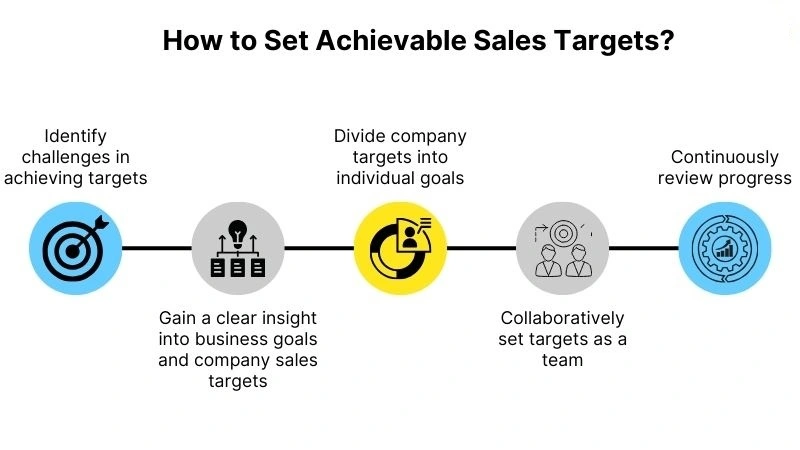How do you set and achieve sales targets?
How do you set and achieve sales targets?
Let us look at how do you set and achieve sales targets? Overseeing a successful sales team requires careful planning and strategic goal-setting. Establishing clear and achievable sales targets is important for driving revenue and measuring success within an organization. In this blog post, we will investigate into the steps and strategies involved in setting and achieving sales targets, outlining key factors that contribute to a high-performing sales team.
Key Takeaways:
- Set SMART Goals: When setting sales targets, ensure they are Specific, Measurable, Achievable, Relevant, and Time-bound.
- Understand Your Market: Conduct market research to identify trends, customer needs, and competitor strategies to set realistic sales targets.
- Regularly Review and Adjust Targets: Monitor progress towards your sales targets frequently and adjust them if needed based on performance and market changes.
- Provide Training and Support: Equip your sales team with the necessary tools, training, and support to help them achieve their targets effectively.
- Celebrate Achievements: Recognize and celebrate when sales targets are met or exceeded to boost morale and motivate your team to continue striving for success.
Understanding Sales Targets
Definition and Purpose of Sales Targets
One of the critical components of a sales strategy is setting sales targets. Sales targets are specific, measurable goals set for the sales team to achieve over a certain period. The purpose of sales targets is to provide a clear direction and motivation for the sales team, ensuring they stay focused on driving revenue and meeting business objectives.
Types of Sales Targets
Sales targets can vary based on the time frame, the sales metric focused on, and the salesperson’s role within the organization. The main types of sales targets include:
- Revenue targets
- Volume targets
- Profit targets
- Activity targets
- Market share targets
After achieving one type of sales target, the sales team can then focus on another to ensure well-rounded success.
Sales targets provide a roadmap for sales teams to know what they need to achieve and how they can contribute to the company’s growth. By setting clear targets, sales professionals can track their progress, identify areas that need improvement, and stay motivated to reach their goals. Setting and achieving sales targets is crucial for the success of any sales organization.
After achieving one type of sales target, the sales team can then focus on another to ensure well-rounded success.
This approach helps in ensuring a balanced effort across different aspects of the sales process and ultimately leads to sustained growth for the business.
| Revenue Targets | Focus on achieving a specific amount of sales revenue within a defined period. |
| Volume Targets | Concentrate on selling a certain number of products or services over a set timeframe. |
| Profit Targets | Aim to reach a particular level of profit margin or overall profit within a given time frame. |
| Activity Targets | Emphasize the number of sales calls, meetings, or other sales-related activities to be completed within a specific period. |
| Market Share Targets | Strive to capture a defined percentage of the market within a specific time frame. |
Setting Sales Targets
Establishing Realistic Sales Goals
Some of the first steps in setting sales targets involve establishing realistic goals that are achievable yet challenging for your sales team. This requires a deep understanding of your company’s historical sales data, market trends, and the capabilities of your sales team. By setting realistic sales goals, you can motivate your team to strive for success while also ensuring that the targets are within reach.
Aligning Targets with Business Objectives
Any successful sales strategy must align sales targets with the overarching business objectives of the company. Realistic sales targets should be set in a way that supports the overall growth and profitability goals of the organization. By ensuring that sales targets are aligned with business objectives, you can drive a more cohesive and focused approach to achieving success in sales.
Realistic sales targets should not only consider the revenue goals of the company but also take into account other key performance indicators such as customer acquisition costs, sales cycle length, and customer lifetime value. By aligning sales targets with these broader business objectives, you can ensure that your sales team is working towards goals that have a meaningful impact on the company’s bottom line.
Understanding the relationship between sales targets and business objectives is crucial for creating a sales strategy that not only drives revenue but also contributes to the overall success and growth of the company. By setting realistic sales targets that align with business objectives, you can create a roadmap for your sales team to follow that leads to sustainable and scalable growth.
Strategies to Achieve Sales Targets
Developing an Action Plan
Action: After setting your sales targets, the next crucial step is developing a detailed action plan. This plan should outline specific steps, timelines, and responsible team members for each task. By breaking down your targets into smaller actionable items, you can effectively track progress and make adjustments as needed to stay on course.
Monitoring and Motivating Sales Team Performance
On: Monitoring and motivating your sales team’s performance is important to achieving sales targets. Regularly tracking key performance indicators (KPIs) such as conversion rates, average deal size, and sales calls can provide insights into individual and team performance. Providing constructive feedback, incentives, and recognizing achievements can also boost motivation and drive results.
A: Additionally, implementing a sales dashboard or CRM system can help automate performance tracking and provide real-time data for informed decision-making. Conducting regular team meetings, trainings, and setting SMART goals can further enhance performance and keep the team focused and motivated towards achieving sales targets.
Utilizing Technology and Tools
CRM and Sales Analytics
Now, more than ever, sales teams are leveraging the power of Customer Relationship Management (CRM) systems and sales analytics tools to set and achieve sales targets effectively. Analytics allow businesses to track sales performance, customer data, and market trends in real-time, empowering teams to make data-driven decisions to optimize sales strategies and maximize revenue.
Automation and Productivity Tools
Now, automation and productivity tools are indispensable for sales teams looking to streamline processes and boost efficiency. These tools encompass a range of technologies, from email automation platforms to sales engagement software, that can automate repetitive tasks, prioritize leads, and provide valuable insights to sales reps. By utilizing these tools, sales teams can focus on building relationships with prospects and closing deals, rather than getting bogged down by administrative tasks.
Plus, with the rise of artificial intelligence and machine learning, these tools are becoming increasingly sophisticated, offering predictive analytics and personalized recommendations to drive sales performance.
Overcoming Common Challenges
Addressing Market Changes
Any successful sales team must be agile and adaptable to address market changes effectively. Whether it’s shifts in consumer behavior, economic fluctuations, or new competitors entering the market, staying ahead requires a keen understanding of the industry landscape. Conduct regular market research, analyze trends, and be ready to pivot your sales strategies to align with the evolving market dynamics.
Dealing with Underperformance
The ability to address underperformance is crucial for achieving sales targets. The first step in addressing underperformance is to identify the root cause. Is it a lack of training, motivation, resources, or a mismatch between individual skills and assigned tasks? Once you pinpoint the issue, provide targeted support, coaching, and feedback to help team members improve their performance and reach their full potential. Keep track of progress and be prepared to make tough decisions if necessary.
To further support underperforming team members, consider implementing a performance improvement plan that outlines specific goals, timelines, and resources for improvement. This structured approach can help clarify expectations and provide a roadmap for gradual progress towards achieving sales targets.
Final Words.
On the whole, setting and achieving sales targets requires a strategic approach that considers market trends, customer needs, and the capabilities of your sales team. Regularly tracking progress, providing feedback, and making adjustments as needed are important steps to ensure success in reaching your sales targets. For more detailed insights on setting effective sales goals for your team.
Hope you have taken learnings from “How do you set and achieve sales targets” If yes please explore Pulse Business. Support the writer Rajdeep Chauhan







